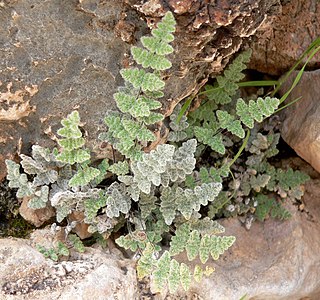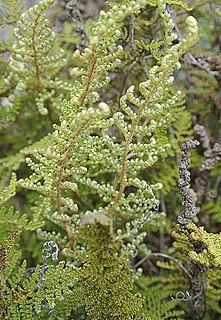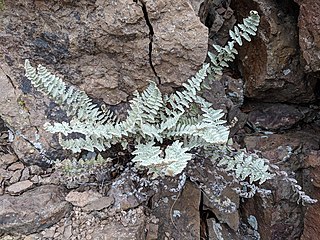
Pteridaceae is a family of ferns in the order Polypodiales, including some 1150 known species in ca 45 genera, divided over five subfamilies. The family includes four groups of genera that are sometimes recognized as separate families: the adiantoid, cheilanthoid, pteridoid, and hemionitidoid ferns. Relationships among these groups remain unclear, and although some recent genetic analyses of the Pteridales suggest that neither the family Pteridaceae nor the major groups within it are all monophyletic, as yet these analyses are insufficiently comprehensive and robust to provide good support for a revision of the order at the family level.

Argyrochosma jonesii, known as Jones' false cloak fern, is a species of fern native to the southwestern United States and Sonora, Mexico. It grows on calcareous rocks, and has small, finely-divided leaves with a leathery texture and dark axes connecting the leaf segments. Unlike many members of Argyrochosma, it does not secrete white powder on the underside of its leaves. First described as a species in 1917, it was transferred to the new genus Argyrochosma in 1987, recognizing their distinctness from the "cloak ferns".

Cheilanthoideae is one of the five subfamilies of the fern family Pteridaceae. The subfamily is thought to be monophyletic, but some of the genera into which it has been divided are not, and the taxonomic status of many of its genera and species remains uncertain, with radically different approaches in use as of December 2019.

Myriopteris tomentosa, formerly known as Cheilanthes tomentosa, is a perennial fern known as woolly lipfern. Woolly lipfern is native to the southern United States, from Pennsylvania to Arizona and Georgia, and Mexico.

Myriopteris myriophylla, the Central American lace fern, is a species of lip fern. Despite its common name, this species is native as far south as Argentina. It is adapted to dry areas.

Myriopteris, commonly known as the lip ferns, is a genus of cheilanthoid ferns. Like other cheilanthoids, they are ferns of dry habitats, reproducing both sexually and apogamously. Many species have leaves divided into a large number of small, bead-like segments, the probable inspiration for the generic name. Hairs and/or scales are often present on both the upper and lower surfaces of the leaf, and their presence and appearance are useful in distinguishing between species. The genus is most diverse in Mexico, but species are found from southwestern Canada south to southern Chile, and one species is endemic to southern Africa.

Myriopteris alabamensis, the Alabama lip fern, is a moderately-sized fern of the United States and Mexico, a member of the family Pteridaceae. Unlike many members of its genus, its leaves have a few hairs on upper and lower surfaces, or lack them entirely. One of the cheilanthoid ferns, it was usually classified in the genus Cheilanthes as Cheilanthes alabamensis until 2013, when the genus Myriopteris was again recognized as separate from Cheilanthes. It typically grows in shade on limestone outcrops.
Myriopteris maxoniana is a species of cheilanthoid fern known only from one collection in Tamaulipas, Mexico. It closely resembles Myriopteris longipila and was not described as a distinct taxon until 2004.
Myriopteris aemula, the Texas lip fern or rival lip fern, is a moderately-sized fern of Texas and Mexico, a member of the family Pteridaceae. Unlike many members of its genus, its leaves have a few hairs on upper and lower surfaces, or lack them entirely. One of the cheilanthoid ferns, it was usually classified in the genus Cheilanthes as Cheilanthes aemula until 2013, when the genus Myriopteris was again recognized as separate from Cheilanthes. It typically grows on limestone rock.
Myriopteris yatskievychiana is a small fern native to Mexico, a member of the family Pteridaceae. It is known only from a single collection in the Mexican state of Sonora. While superficially similar to golden lip fern, a widespread species in Mexico, differences in its coating of hairs and its small size make it distinctive. One of the cheilanthoid ferns, it was usually classified in the genus Cheilanthes until 2013, when the genus Myriopteris was again recognized as separate from Cheilanthes.
Myriopteris allosuroides is a moderately-sized fern of Mexico, a member of the family Pteridaceae. Unlike many members of its genus, its rachides are grooved on the upper surface and largely free of hairs or scales. One of the cheilanthoid ferns, it was usually classified in the genera Cheilanthes or Pellaea until 2013, when the genus Myriopteris was again recognized as separate from Cheilanthes. It typically grows on dry, rocky slopes over acidic, particularly basaltic, rock.
Argyrochosma pallens is a fern endemic to Mexico. It has narrow, divided leaves with brown axes; the leaves are dusted with white powder above and coated in it below. First described as a species in 1956, it was transferred to the new genus Argyrochosma in 1987, recognizing their distinctness from the "cloak ferns".

Myriopteris aurea, the golden lip fern or Bonaire lip fern, is a moderately-sized fern native to the Americas, a member of the family Pteridaceae. Unlike many members of its genus, its leaf is only modestly dissected into lobed leaflets (pinnae), which are hairy both above and below. One of the cheilanthoid ferns, it was usually classified in the genera Cheilanthes as Cheilanthes bonariensis until 2013, when the genus Myriopteris was again recognized as separate from Cheilanthes. It typically grows on dry, rocky slopes, and ranges from Mexico, where it is extremely common and widespread, and the southwestern United States south and east through Central and South America as far as Chile and Argentina.
Argyrochosma lumholtzii is a rare fern in the family Pteridaceae known from Sonora, Mexico. It is quite similar to Jones' false cloak fern, but has black leaf axes and a less highly divided leaf. First described as a species in 1939, honoring the explorer Carl Sofus Lumholtz, it was transferred to the new genus Argyrochosma in 1987, recognizing their distinctness from the "cloak ferns".

Argyrochosma fendleri, Fendler's false cloak fern, is a fern known from the western United States and northwestern Mexico. It grows in rocky habitats, and is distinguished from other members of the genus by its zig-zag leaf axes. Like many species in the genus, it bears white powder on the underside of its leaves. First described as a species in 1851, it was transferred to the new genus Argyrochosma in 1987, recognizing their distinctness from the "cloak ferns".
Argyrochosma incana, the hairy false cloak fern, is a fern known from the southwestern United States through Mexico to Guatemala, and from a disjunct population in the Dominican Republic. It grows on rocky slopes and steep banks, often in forests. Like many of the false cloak ferns, it bears white powder on the underside of its leaves. First described as a species in 1825, it was transferred to the new genus Argyrochosma in 1987, recognizing their distinctness from the "cloak ferns".
Argyrochosma formosa is a fern known from eastern and central Mexico and Guatemala. It grows on rocky slopes, particularly on limestone. Unlike many members of the genus, it lacks white powder on the underside of its leaves. First described as a species in 1842, it was transferred to the new genus Argyrochosma in 1987, recognizing their distinctness from the "cloak ferns".

Argyrochosma limitanea, the southwestern false cloak fern, is a species of fern native to the southwestern United States and Sonora, Mexico. It grows on calcareous rocks, and has small, finely-divided leaves with a leathery texture, dark axes connecting the leaf segments, and a heavy coating of white powder on the undersurface. It reproduces apogamously; two subspecies are recognized, which may have originated independently through the hybridization of other taxa not yet discovered. First described as a species in 1919, it was transferred to the new genus Argyrochosma in 1987, recognizing their distinctness from the "cloak ferns".

Argyrochosma microphylla, the small-leaf false cloak fern, is a species of fern native to New Mexico, Texas and northern Mexico. It grows on limestone rocks and cliffs, and has finely-divided leaves with small leaf segments, often folded in half when dry, which lack the white powder present on the leaf underside of many related species. First described as a species in 1869, it was transferred to the new genus Argyrochosma in 1987, recognizing their distinctness from the "cloak ferns".

Myriopteris rufa, commonly known as Eaton's lip fern, is a moderately-sized fern of Mexico and the southwestern United States, with outlying populations in Costa Rica and the Appalachian Mountains. One of the cheilanthoid ferns, it was usually classified in the genus Cheilanthes, as Cheilanthes eatonii, until 2013, when the genus Myriopteris was again recognized as separate from Cheilanthes. It typically grows in rocky habitats, most frequently on limestone but also sometimes on basalt or shale.













